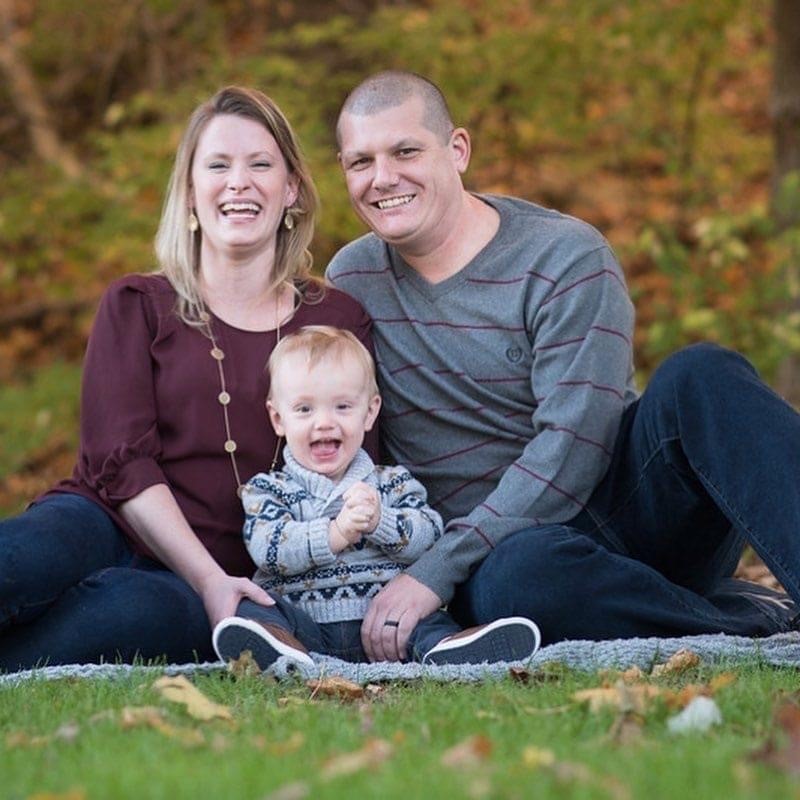The story of Emily
My husband and I met for dinner at a local restaurant, quickly ordering and trying to scarf some food down before Logan woke up and was ready to eat again. About 3 bites into our nachos, I looked up and Logan was stirring, dangerously close to shrieking for his dinner. As I tried to quickly grab his diaper bag to make him a bottle, I watched as his eyes widened and his arms came shooting out, like he was terrified. It lasted for only a second, and as I turned to ask Chris if he saw what happened Logan made the same motion again. Although it didn’t sit right with me we also didn’t see it again, so we fed him, ate our dinner, and went on our way back home.
Over the coming days, I noticed Logan making the same motion at times. It would occur a few times in a row, each episode lasting only a second. His little body would contract in as his arms and legs jutted out, eye wide as if he had seen a ghost…but he would immediately go back to playing or whatever he was doing. In passing, I happened to mention it to my sister, a pediatric neurology NP. “If you can, try to get it on video” was her advice. When I asked why, she was cagey and said she just wanted to see what he was doing. So like any good parent, I started googling away and found a video on The Epilepsy Foundation website featuring Infantile Spasms. I knew without a doubt that this was what we had been seeing. I started reading, and once I did I couldn’t stop: an epilepsy syndrome diagnosed in only 2% of all epilepsy cases….developmental delays and/or developmental regression…severe intellectual impairment…high rates of autism and comorbid intractable seizure disorders…up to 60% mortality by age 10. I felt like something was sitting on my chest and I thought I was going to vomit. When Chris got home, he found me alone in the kitchen crying, Logan long asleep in his room. I told him we needed to talk, and I didn’t want him to think I was crazy. After showing him the videos and relaying the information that I found, we pow-wowed with my sister and came up with a plan: we would get the motion on video and she would let us know if she thought it was suspicious and send it over to her colleagues for their input as well.
At 4am on a Friday morning, Chris and I caught the motion on video and texted it over to her. From there, everything was a whirlwind. Just mere hours later, the video had been passed around by numerous top-of-their-field neurologists at Hopkins. They all agreed the video was concerning, but they were doubtful it was in fact IS; after all, this uncommon illness normally is seen around the 6th month of life, and our son was only 2 months old. In addition, IS can mimic an exaggerated Moro (Startle) Reflex or even reflux. To be on the safe side, we were asked to drive down to Johns Hopkins in Baltimore to be seen in the ER for an EEG with the understanding that if nothing was found (which is what we hoped for), we would return home and follow up with our PCP.
Within minutes we were checked in, triaged, and brought back to a room. The ER physician was kind and let us know that she had contacted Neurology so they could come down to wire his head for the EEG. When the techs arrived, they began the arduous process of cleaning his skin and gluing tiny little electrodes to his head. Once finished, they wrapped his head in gauze like a turban and started to record his brain waves. Pretty quickly, the neurologist noted his EEG was abnormal and Logan had a cluster of spasms in front of the team. In addition to a full neurological exam, a physical exam including an inspection of his skin under a Woods Lamp was performed to assess for skin lesions associated with Tuberous Sclerosis. They obtained blood and urine samples to be sent as part of the work up, and ordered for a MRI to assess for lesions or evidence of injury in the brain. We were moved to the 9th floor with our heads spinning. Was it not less than 24 hours ago we thought it was just reflux? We went down for his MRI around midnight, and they wedged his little body with pillows and positioning pads to try and keep him still to avoid having to place a breathing tube and sedate him. I have never been more happy that he grew in the womb surrounded by renovation and demolition noise, because overall the loud beeping and clicking of the MRI hardly phased him. With a normal MRI and nothing special identified on his lab work, we were started on high dose steroids. His appetite immediately increased and he developed “roid rage” but overall he tolerated the steroids well. We were sent home tired and confused but grateful for the care that we received, and hoped that the meds would work their magic and the spasms would cease.
Since that time, Logan’s had multiple hospitalizations and 6 neurosurgeries, including a partial then full left temporal lobectomy. He is now seizure free but remains globally delayed. We are more focused on social integration and long term goals focusing on functional independence. We are so grateful for the community of parents of differently abled children, and hope to find treatments in the future that could better suit our son’s needs.
